How to Use Big Data in Freight Transportation?
Big data has given the transportation sector a valuable tool for optimizing operations and improving outcomes. Before delving into the details, it is critical to grasp what big data comprises. Big data refers to extraordinarily massive and complicated data volumes that are difficult to handle and analyze using conventional approaches. Big data in freight transportation refers to a wide range of information, such as shipment details, weather conditions, fuel costs, traffic patterns, and client preferences. Transportation businesses may acquire useful insights and make better decisions by leveraging this data and employing advanced analytics.
Now, let’s delve into the various ways in which big data can be leveraged in the freight transportation industry, revolutionizing the way goods are moved across the globe.
Section 1: Predictive Analytics for Demand Forecasting
One of the key challenges in freight transportation is accurately predicting demand. Traditionally, companies relied on historical data and market trends to estimate future demand. However, these methods were often imprecise and did not account for real-time factors that could impact demand. With big data, transportation companies can leverage predictive analytics to gain a deeper understanding of demand patterns and anticipate fluctuations.
Transportation companies can develop sophisticated models that predict demand with greater accuracy by analyzing historical shipment data, weather patterns, economic indicators, and social media sentiment. For example, a company may identify that during certain weather conditions, there is a higher demand for cold storage transportation. Armed with this insight, the company can proactively allocate resources and adjust its operations to meet the anticipated demand, reducing the risk of overcapacity or missed opportunities.
Furthermore, big data can enable transportation companies to identify emerging trends and market shifts. By monitoring social media conversations, news articles, and industry reports, companies can stay ahead of the curve and adapt their strategies accordingly. For instance, companies can quickly respond by reallocating resources or adjusting pricing if there is a sudden surge in demand for a specific product. This agility can give companies a competitive edge in a rapidly evolving market.
Section 2: Optimization of Route Planning and Asset Utilization
In freight transportation, efficient route planning is crucial to minimize fuel consumption, reduce transit times, and optimize asset utilization. Traditionally, route planning was based on historical data and general knowledge of traffic patterns. However, this approach often led to suboptimal routes and wasted resources. Big data analytics can revolutionize route planning by incorporating real-time data and predictive insights.
By analyzing data from GPS devices, traffic sensors, and weather forecasts, transportation companies can identify the most efficient routes for their fleets. For example, if a major accident occurs on a particular highway, the system can automatically reroute trucks to avoid congestion. Additionally, big data can help companies optimize asset utilization by identifying opportunities for backhauling and load balancing.
Furthermore, big data can enable transportation companies to optimize fuel consumption by analyzing factors such as weather conditions, traffic patterns, and vehicle performance data. Companies can significantly reduce their carbon footprint and operational costs by identifying the most fuel-efficient routes and optimizing driving behavior. This not only benefits the environment but also enhances the company’s reputation and appeal to environmentally conscious customers.
Section 3: Enhancing Supply Chain Visibility and Security
Supply chain visibility is critical for ensuring the smooth flow of goods and minimizing disruptions. However, traditional supply chain systems often lack real-time visibility and transparency, making it difficult to identify bottlenecks or potential issues. Big data can address this challenge by providing real-time insights into every step of the supply chain.
By integrating data from various sources, such as GPS trackers, RFID tags, and IoT devices, transportation companies can track shipments Flogistic in real-time and gain a holistic view of the supply chain. This visibility enables companies to proactively address issues, such as delays or quality concerns before they escalate. For example, if a shipment is delayed due to adverse weather conditions, the company can quickly notify the customer and make alternative arrangements to minimize the impact.
In addition to enhancing visibility, big data can also play a crucial role in supply chain security. By analyzing data from various sources, such as cargo sensors, surveillance cameras, and historical crime patterns, transportation companies can identify potential security risks and take proactive measures to mitigate them. For instance, if a certain route is known for high theft rates, the company can deploy additional security measures or choose an alternative route to minimize the risk.
Also Read:- Using AI to Improve End-to-End Supply Chain Management
Conclusion
The adoption of big data in freight transportation has the potential to revolutionize the industry. Predictive analytics boosts transportation efficiency. It optimizes routes and asset use, saving costs. Enhanced supply chain visibility and security follow. Yet, big data needs a strong infrastructure and skilled analysts. A data-driven culture is key. Advancing tech increases available data. This boosts big data’s role in freight. It leads to a more connected, efficient, and sustainable sector. Future growth is assured as technology progresses and data expands. Leveraging big data promises innovation in transportation. Shorter sentences ensure clarity and directness in conveying the message about big data’s role in improving transportation logistics and operations.




Recent Comments